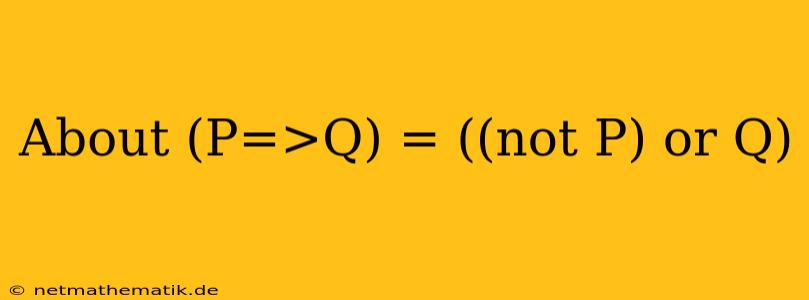The logical equivalence between the conditional statement (P=>Q) and its equivalent ((not P) or Q) is a fundamental concept in logic and forms the basis for numerous logical deductions and proofs. This equivalence, often referred to as the material conditional, is a powerful tool for simplifying complex logical expressions and understanding the relationships between propositions. This article will delve into the meaning, proof, and applications of this key logical equivalence.
Understanding the Material Conditional
The statement (P=>Q), read as "if P then Q", asserts that the truth of P necessitates the truth of Q. In other words, if P is true, then Q must also be true. This does not necessarily imply a causal relationship between P and Q, but rather a logical connection where the truth of Q is dependent on the truth of P.
((not P) or Q), on the other hand, states that either P is false or Q is true. This may seem different from the conditional statement, but it effectively captures the same logical relationship. If P is true, then Q must also be true to make the statement ((not P) or Q) true.
The key to understanding the equivalence lies in considering the scenarios where the conditional statement is false. The conditional statement (P=>Q) is only false when P is true and Q is false. This aligns perfectly with the equivalent statement ((not P) or Q), which is also false when P is true and Q is false.
Proof of Equivalence
The equivalence between (P=>Q) and ((not P) or Q) can be demonstrated through a truth table:
| P | Q | (P=>Q) | (not P) | ((not P) or Q) |
|---|---|---|---|---|
| T | T | T | F | T |
| T | F | F | F | F |
| F | T | T | T | T |
| F | F | T | T | T |
As shown in the truth table, both (P=>Q) and ((not P) or Q) have the same truth values for all possible combinations of truth values for P and Q. This demonstrates their logical equivalence.
Applications of the Material Conditional
The material conditional equivalence finds extensive applications in various areas, including:
1. Logic and Proof:
The equivalence plays a crucial role in constructing logical arguments and proofs. It allows us to rewrite conditional statements in a form that facilitates easier manipulation and derivation of new conclusions.
2. Programming and Computer Science:
In programming languages, conditional statements like "if...then...else" are based on the material conditional. The equivalence enables efficient code implementation and logical reasoning within software systems.
3. Set Theory and Mathematics:
The equivalence is fundamental in set theory, where it forms the basis for defining the implication operator and exploring set relationships. It also plays a significant role in various mathematical proofs and derivations.
4. Reasoning and Argumentation:
Understanding the material conditional helps in analyzing arguments, identifying fallacies, and constructing valid arguments. It allows us to evaluate the logical structure of statements and ensure the soundness of conclusions.
Example and Illustration
Let's illustrate the concept with a simple example:
- P: It is raining.
- Q: The ground is wet.
The conditional statement (P=>Q) would be "If it is raining, then the ground is wet."
The equivalent statement ((not P) or Q) translates to "It is not raining or the ground is wet."
These two statements have the same meaning and truth value. If it is raining and the ground is dry, then both statements are false. In all other scenarios, both statements are true.
Conclusion
The equivalence between the conditional statement (P=>Q) and ((not P) or Q) is a cornerstone of logic and reasoning. Its understanding is vital for constructing valid arguments, simplifying complex logical expressions, and manipulating propositions in various fields. By grasping this equivalence, we gain a deeper understanding of the connections between propositions and the principles of logical reasoning. The material conditional serves as a powerful tool for logical analysis and is a fundamental concept that underlies much of our understanding of how arguments and statements function.
